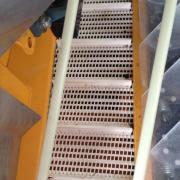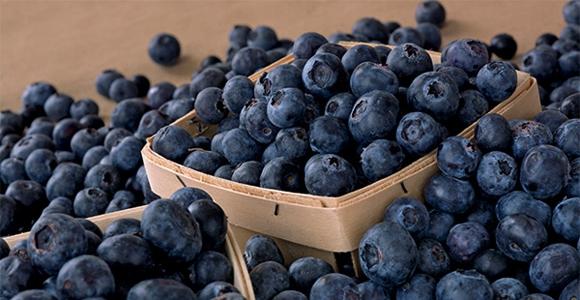Mechanical harvesting of blueberries is commonplace in many commercial production regions. With labor shortages becoming worse and expenses associated with labor ever-increasing, it is a strategy that more producers would like to employ for the fresh market. Commonly, food safety hazards are linked to human contact, but mechanical harvesters may also lead to safety issues especially if they are not cleaned and maintained properly. Possible contaminants include bacteria, yeast, mold, coliform, fecal coliform, and enterococcus. Here are some tips to minimize food safety problems:
- Know when and where the harvester was used last to rule out potential contamination through contact with high risk sources such as compost or manure
- Make sure the harvester is in good working order. Any broken, damaged, or leaking parts could lead to fruit contamination.
- Always clean and sanitize the harvester before and after each harvest, especially any surface that comes into contact with the fruit. These may include catch plates, conveyer belts, walls, “fish scales”, etc. Also clean and sanitize the harvester when it is moved between fields.
- No drinking, eating, or smoking should be done while operating the harvest machine. These activities may create physical hazards (e.g. plastic or glass contamination) or other contamination.
Some harvester surfaces such as conveyors, catch plates, and walls tend to have a higher potential for indicator microorganisms (Fig. 1). Growers should visually inspect harvesters before and after cleaning for debris and trapped soil material. Lugs used for harvest can also be a source of contamination. It is important for growers to take care in how lugs are handled and stored, keeping in mind that moisture can promote growth of microorganisms and surroundings, such as areas for birds to perch, can be a potential source of contamination. Indicator microorganisms are not necessarily problematic, but they suggest the potential presence of undesirable microbial contaminants. Clean water sources, materials, and equipment should be used for cleaning harvesters. A cleaning step is needed before application of a sanitizer, unless removal of debris and sanitization can occur simultaneously, like with the use of a high-pressure washer with steam. Cleansers include detergents and degreasers, and sanitizer options include bleach, quaternary ammonium, chlorine dioxide, etc.
 A
A  B
B  C
C
Fig. 1. Examples of harvester surfaces A) catch plate, also known as fish scales, B) conveyor belt, C) lug (Photos courtesy of Renee Allen, University of Georgia).
To best minimize microbial contamination and subsequent fruit loss, harvest when the fruit is dry and during the coolest part of the day. Also, after the fruit is harvested, avoid dropping and vibrating the fruit as much as possible which can create bruises or other damage (Fig. 2). Do not over pack fruit in lugs or other field containers. The fruit should be no more than 4 to 5 inches deep so that it does not become crushed. Handle all fruit delicately and cool it as soon as possible by getting it out of the field once it is harvested.
Once the fruit is out of the field and into the packing facility, other food safety awareness is needed. But, the above information regarding blueberry harvester food safety can mitigate many potential problems before the fruit is packed and shipped.

Fig. 2. Blueberry fruit moving along a conveyor belt into a lug. The fruit drops from the belt onto a hard plastic surface potentially causing bruising and reduction in shelf life. (Photo courtesy of Dr. Jeff Williamson, University of Florida).
Authors:
Eric Stafne, Mississippi State University
Renee Allen, University of Georgia
